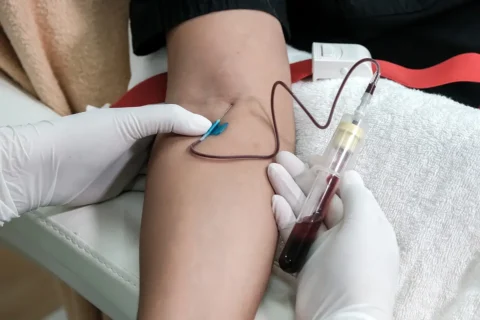Tirzepatide and semaglutide are two cutting-edge medications that hold promise for helping people manage their weight in an effective yet friendly manner.
Both drugs work by targeting important hormones involved in weight control, but they go about it in slightly different ways.
If you’re looking for a helping hand to shed some extra pounds, these modern marvels may lend you a helping hand – though as with all medicines, they aren’t magic bullets but part of an overall weight-loss strategy.
Tirzepatide
Tirzepatide is a once-weekly injectable treatment based around a double whammy of hormone-regulating action. It targets glucose dependent insulinotropic polypeptide and glucagon-like peptide 1 receptors in the body, potentially giving it an edge over medications that only address one or the other.
By balancing blood glucose and food intake, it can assist in weight management and body weight reduction efforts.
In clinical studies, tirzepatide has demonstrated its powerful effects. With a high dose of tirzepatide, individuals tended to experience significant weight loss – averaging around 15% of their body weight! That’s no small feat.
Here are some key findings from the tirzepatide study for obesity treatment:
- Tirzepatide led to significant weight loss compared to placebo at doses of 5 mg, 10 mg and 15 mg weekly. At 72 weeks, the mean weight loss was 15.0%, 19.5%, and 20.9% in the tirzepatide groups vs 3.1% for placebo.
- A high proportion of participants on tirzepatide achieved clinically meaningful weight loss of ≥5%, ≥10%, ≥15%, and ≥20% body weight compared to placebo. For example, 89-91% on 10-15 mg tirzepatide lost ≥5% versus 35% on placebo.
- Tirzepatide resulted in improvements in waist circumference, blood pressure, lipids, insulin levels, and physical functioning compared to placebo, indicating benefits on cardiometabolic risk factors.
- The most common side effects with tirzepatide were gastrointestinal like nausea, diarrhea and vomiting, mostly mild-moderate in severity and occurring during dose escalation.
- Discontinuations due to adverse events were slightly higher with tirzepatide (4.3-7.1%) versus placebo (2.6%).
However, as you’d expect with any medication, side effects like nausea and loss of appetite occurred for some patients taking tirzepatide.
Overall, tirzepatide seems like the type of diabetes mellitus drug that provides a helpful companion for the journey towards reaching a healthy weight. Though keep in mind that proper diet and exercise will always remain core elements of an effective weight management routine. Tirzepatide is just one tool in your toolbox.
Semaglutide
Semaglutide, on the other hand, tackles many of the same weight-related issues but in a slightly different way.
This glp-1 receptor agonist seeks to balance hormones and eating behaviors by activating the glucagon-like peptide 1 receptor in the body, especially in the pancreas and gut.
Overall, semaglutide has proven to be an effective aid for weight loss in clinical studies. Doses as low as 0.5 mg per week helped people lose an average of five to ten percent of their body weight, while higher doses led to reductions of fifteen percent or more.
That puts it in the same weight loss ballpark as tirzepatide.
Here are some key findings from the semaglutide study for obesity treatment:
- Semaglutide led to significant weight loss at a dose of 2.4 mg weekly subcutaneously compared to placebo. At 68 weeks, the mean weight loss was 14.9% in the semaglutide group vs 2.4% with placebo.
- A high percentage of participants on semaglutide 2.4 mg achieved clinically meaningful weight loss of ≥5% (86%), ≥10% (69%), ≥15% (53%) and ≥20% (34%) compared to placebo (31%, 12%, 4%, 0.7% respectively).
- Semaglutide resulted in significant improvements in waist circumference, systolic blood pressure, lipids, and physical functioning compared to placebo.
- The most common adverse events with semaglutide were gastrointestinal like nausea, diarrhea, vomiting and constipation. Most were mild-moderate and transient.
- Discontinuations due to adverse events were higher with semaglutide (11.6%) compared to placebo (5.2%).
Just like with tirzepatide, side effects are common with semaglutide but tend to be mild to moderate in severity.
Digestive issues like constipation, diarrhea, and upset stomach ranked among the most frequent complaints. Nausea was also a common side effect, especially when first starting semaglutide treatment.
To put the hormones into action, semaglutide functions as regular injections you give yourself just once per week. You start at a low dose and gradually increase to higher doses over the course of a few months as your body adjusts.
Overall, semaglutide comes across as a reliable companion for your weight loss journey. It helps give your efforts an extra boost through hormonal tweaks that curb appetite and increase feelings of fullness.
However, as with any medication, remember that semaglutide works best when paired alongside a healthy diet and ample physical activity.
Tirzepatide vs Semaglutide: Key Differences

When it comes down to the nitty gritty, there are a few key differences between tirzepatide and semaglutide:
Dual action vs single action
Tirzepatide works by activating two hormone receptors – GLP-1 and GIP – giving it a potential edge over semaglutide, which only targets the GLP-1 receptor. By influencing two pathways instead of one, tirzepatide may provide greater effects on blood glucose, appetite, and weight loss.
Higher potency
Some studies suggest that tirzepatide’s dual action mechanism may make it a more potent medication for weight loss compared to semaglutide. There is evidence that tirzepatide leads to greater reductions in body weight andBMI in clinical trials. However, more head-to-head research is needed to make definitive conclusions.
Cost
Currently, tirzepatide costs more than semaglutide. However, some studies indicate that tirzepatide offers better “value for money” or cost-effectiveness due to its somewhat greater weight loss effects compared to semaglutide at equivalent doses.
Administration
Both medications require once-weekly injections. However, semaglutide has an oral formulation in addition to the injectable form. Tirzepatide is currently only available as an injection.
Overall, both tirzepatide and semaglutide have demonstrated effectiveness for weight loss. However, there are some notable differences in their mechanisms of action, potency, costs, and administration forms.
While more research is needed, early studies hint that tirzepatide may provide a slight advantage compared to semaglutide – though at a higher price currently. The bottom line is that both medications can serve as valuable aids when combined with lifestyle changes for optimal weight loss results.
Side Effects Comparison
When it comes to side effects, tirzepatide and semaglutide exhibit many similarities due to their similar mechanisms of action. However, there are some minor differences worth noting:
Common to both:
- Nausea – This is a common side effect for both medications, especially at the beginning of treatment. However, nausea tends to improve over time for most patients.
- Diarrhea – Both medications can cause loose stools or an increased incidence of diarrhea.
- Vomiting – Some individuals experience vomiting or episodes of throwing up while on either tirzepatide or semaglutide.
- Low blood sugar (hypoglycemia) – When used for diabetes treatment, both medications can occasionally cause low blood sugar. However, hypoglycemia is generally mild and manageable.
Differences:
- Abdominal pain – Reported slightly more frequently with tirzepatide than semaglutide.
- Decreased appetite – More often cited as a side effect of tirzepatide compared to semaglutide. This may be due to tirzepatide’s dual action mechanism.
- Injection site reactions – Occur with both drugs, though slightly more commonly with semaglutide. Possible causes include irritation, redness, itching and pain at the injection site.
Overall, real-world experience suggests that the likelihood, frequency and severity of side effects are similar between tirzepatide and semaglutide.
The majority of side effects tend to be mild and transient, improving over time as the body adjusts. However, individuals respond differently, so it’s important to monitor your experience closely when starting either medication.
Talk to your doctor immediately if side effects become bothersome or interfere with normal activities.
Cost Comparison: Tirzepatide vs. Semaglutide
When it comes to cost, there is a notable difference between tirzepatide and semaglutide:
Tirzepatide costs more than semaglutide, though analysts believe it offers better “value for money” in terms of weight loss:
Tirzepatide (Mounjaro) costs between $930 and $1,360 per month, depending on dosage. This makes it one of the most expensive type 2 diabetes treatments currently available.
Semaglutide (Ozempic and Rybelsus) costs approximately $670 to $850 per month, with Ozempic costing slightly more due to more frequent dosing.
Insurance coverage for both medications varies by plan. Some plans may cover one drug but not the other, or may require prior authorization for either treatment. Patients should check with their insurers about coverage for tirzepatide and semaglutide.
The cost difference between the two drugs is likely to narrow over time as generic versions of semaglutide become available after patent expiration in 2025. This could make semaglutide even more affordable relative to tirzepatide.
FAQ: Tirzepatide vs. Semaglutide
Can patients with type 2 diabetes use tirzepatide or semaglutide?
Both tirzepatide and semaglutide are approved by the FDA for the treatment of type 2 diabetes. They work by different mechanisms but are both effective at lowering blood sugar levels and A1C through similar modes of action as dual glucose-lowering incretin hormones.
Do these drugs help with weight loss in patients with type 2 diabetes?
Yes! In addition to controlling blood sugar, both tirzepatide and semaglutide have been shown in clinical trials to promote significant weight loss in patients with type 2 diabetes. This is due to their effects on slowing gastric emptying, increasing satiety, and reducing appetite.
Are there any cardiovascular benefits of GLP-1 agonists like tirzepatide and semaglutide?
Some research has suggested that GLP-1 receptor agonists may offer cardiovascular benefits beyond glycemic control alone. Possible benefits include lowering blood pressure and cholesterol as well as reducing inflammation and oxidative stress. However, more studies are needed to determine if these effects translate into reduced risks for heart disease.
What are the primary differences between tirzepatide and semaglutide?
The main differences are:
- Tirzepatide is a dual GLP-1/GIP receptor agonist while semaglutide only targets the GLP-1 receptor
- Tirzepatide appears to be more potent for weight loss
- Tirzepatide is significantly more expensive
- Semaglutide has an oral formulation in addition to injections
Is one treatment likely to be more effective than the other?
While some studies suggest tirzepatide may be slightly more effective for weight loss, both medications – when used alongside lifestyle changes – can be highly effective treatments for managing weight and glycemic control in patients with type 2 diabetes. Overall effectiveness depends more on individual factors and adherence to treatment.
Conclusion
In conclusion, both tirzepatide and semaglutide have shown great promise as treatments for both type 2 diabetes and chronic weight management. There are some key differences between the two medications:
Tirzepatide is a newer, dual-action drug that targets two hormone receptors. This may give it a small advantage in terms of weight loss efficacy compared to semaglutide, which only targets one receptor. However, further research is needed.
Tirzepatide is more expensive than semaglutide but has been shown in some studies to provide better “value for money” due to its greater weight loss effects at equivalent doses.
Both drugs exhibit mostly similar side effect profiles, with nausea, diarrhea and vomiting being common. However, some differences do exist between specific side effects reported for each drug.
Semaglutide has an oral formulation in addition to its injectable form, while tirzepatide currently only comes as an injection.
Insurance coverage and out-of-pocket costs vary significantly between patients for both medications. Individual cost comparisons are important.
While tirzepatide may have a slight advantage in terms of weight loss, especially for patients with more to lose, semaglutide remains an excellent option – particularly for patients seeking to control blood sugars first and weight second.
The differences between these treatments are less important than individual factors like insurance, affordability, ease of use, side effects and doctor recommendations.
Overall, both tirzepatide and semaglutide provide valuable tools to support weight loss goals when used as part of a comprehensive program involving diet, exercise and lifestyle changes. Talking to your doctor can help you determine which treatment, if either, may be right for you based on your specific health profile and goals.
The most important thing is to find an effective weight loss medication you can afford and tolerate well – whether that ends up being tirzepatide, semaglutide or another option entirely. With the right support, resources and perseverance, sustainable success is within reach.






